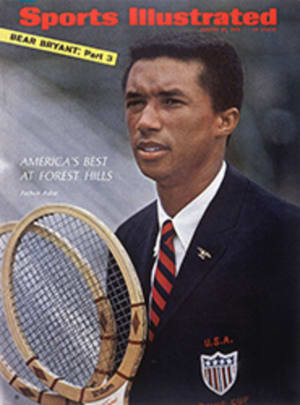
ROUND ONE AT FOREST HILLS
NO TENNIS TRAITORS ALLOWED
You are looking at The West Side Tennis Club in Forest Hills, N.Y., where next week the U.S. singles championships will be played. The 13,400-seat stadium in the foreground is nearly empty because the tournament has just started and there are matches competing for attention on 14 other grass courts. For a spectator, this is the best time to watch tennis. One can stroll from court to court and sample a wide variety of styles: the solemn-faced junior champion from southern California taking on the happy-go-lucky world traveler from Brazil, the little red-haired French girl with the odd-looking but effective backhand, the 43-year-old ex-Davis Cupper still savvy enough to handle the Indian who is studying at Notre Dame. Later the top players in the world will meet inside the stadium for the finals, and every seat will be filled, but for the real tennis buff the best part of the tournament will be over.
The West Side Tennis Club is a triangular-shaped Eden of 12½ acres wedged like a ship's prow into the sea of middle-class conformity that is Forest Hills, in Queens County, New York City.
Surrounding the club are the burgeoning impedimenta of increasingly crowded suburban living. On one side are the small but well-manicured private lawns of Forest Hills Gardens, a high-priced community of houses built during the '20s and '30s. On the other side, beyond the tracks of the Long Island Rail Road, rise new middle-priced apartments, where owners can—but seldom do—sit on their concrete-slab terraces to catch the view of Manhattan's towers only eight miles away in the smog. And nearby, on busy Queens Boulevard, is a neon-lighted delicatessen-and-Chinese-restaurant society, replete with cleaning establishments, air-conditioned movie houses and that modern meeting hall, the laundromat.
In this maelstrom of domesticity, baby production and simulated escape from the horrors of city dwelling, The West Side Tennis Club sits serenely, so dowagerlike that one almost wants to ask, "What's a nice girl like you doing in a place like this?"
Here, inside the club's protected walls, members and their guests can still get a genuine grass stain on their pants and play tennis beneath a sign with a quotation from Kipling that reads: IF YOU CAN MEET WITH TRIUMPH AND DISASTER/AND TREAT THOSE TWO IMPOSTORS JUST THE SAME. Here Thursday is still "lobster night," and members know that Charles will be on hand to see that everything is just so in the dining room. Here no one has to be warned that only white clothes are acceptable on the courts, because everyone knows the only variation possible is the old-fashioned creamy white flannel that turns yellow with the years. Here the cable-stitch sweater is still in fashion, there is only one honorary woman member (Helen Wills Roark) and Jinx Falkenburg's mother is still considered a celebrity. There is none of your ordinary country-club something-for-everyone syndrome at West Side—no swimming pool, billiard table, golf course or modern club activity. As one oldtimer says, "We are not traitors to this game. There is nothing going on at West Side but tennis." (That excepts an occasional cotillion or deb party given by members and those famous concerts by the Beatles, Barbra, Ella et al., for which the club annually rents its stadium in the interest of good business.)
The West Side Tennis Club is a tennis club, all right; in fact, it is the tennis club of America, but it isn't on the west side of anything. Back in the days of its creation (1892) it was located on Central Park West between 88th and 89th Streets in Manhattan. Though it has moved three times in its 74-year history, it has never bothered to change its name. This is typical of the unprepossessing atmosphere on Tennis Place in Forest Hills, where the entrance to the club is marked only by a small, dark sign, discreetly lettered: THE WEST SIDE TENNIS CLUB. PRIVATE CLUB. MEMBERS ONLY.
The 80,000 tennis fans who jam the 13,400-seat stadium each September for the nationals seldom stop to think twice about their host, which owns and leases the stadium for these world-famous amateur championships. The U.S. Lawn Tennis Association has been staging the nationals at Forest Hills for so many years (since 1915) that the club and the event are inextricably intertwined. Past efforts to end the contract and take the nationals elsewhere have always ended in a West Side victory.
And so Forest Hills has remained the center of the U.S. tennis world. The visitor there will see an ivy-covered Tudor clubhouse built in 1914 for only $30,000. Before its red roof lie landscaped velvety courts with self-watering underground pipe systems, a tea garden with gay blue-and-yellow umbrellas (the club colors), climbing roses, trimmed hedges and beautiful flower beds. The clubhouse itself has a few public rooms, a lounge with understated décor and some simple silver trophies, a dining room, cramped offices, the pro shop of Bill Lufler and overcrowded locker rooms.
Sitting comfortably on the clubhouse porch listening to the plop of balls, the ping of rackets and the tinkle of ice, the old big-tennis days are easily recalled—the duels of Bill Tilden and Bill Johnston, historic events involving Molla Mallory and Suzanne Lenglen, the 16-year-old Helen Wills fresh from California, the coming of the French Musketeers and Helen Jacobs and Alice Marble. And someone will always be around to tell you about the club's former pro, George Agutter, who could hold 14 tennis balls in one hand. (Current Pro Lufler has his hands full teaching more than half the membership and is booked one year in advance.)
One of the beauties of the club is that it is just a 16-minute ride from Penn Station in New York City and then a short walk from the Forest Hills station. The IND subway (trains E or F) to Continental Avenue takes about 10 minutes longer. But woe betide the person who looks for a taxi in Forest Hills or brings his own car. Lack of parking space is the bane of the club's existence, for it is more or less trapped inside its expensive triangle, surrounded by homes and apartments and the nearby popular Forest Hills Inn.
But lack of parking space cannot dampen the enthusiasm of the club's members for next week's nationals, the premier event in U.S. tennis. For a year volunteer members have been arranging hospitality, hotels and time schedules for more than 250 amateur players from some 25 countries. Will this be the year the Americans dominate (next page) and put the Aussies in the shade? Whatever happens, The West Side Tennis Club will remain a gracious and impartial host, a reminder of a disappearing era of luxurious living.
PHOTO
HANS KNOPF
THREE PHOTOS
HANS KNOPF
EXCITEMENT occurs early in the tournament when the luck of the draw pits two name players such as Charlie Pasarell (serving) and Fred Stolle. When the match is over, many people will wander back to the clubhouse (top right), order a cool drink and, along with players like Roy Emerson (right, dark blazer), watch two unknowns battle it out in the dusk.
PHOTO
HANS KNOPF
Even as tournament play continues, a version of cricket's tea interval takes place on the pleasant veranda.

